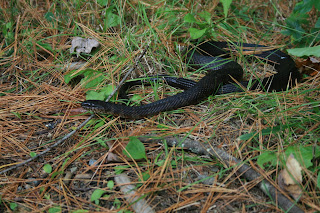I wrote this piece on black racers last week, after I thought I had spotted two black racers in New Hampshire. I submitted photos of one to the NH Fish and Game Department (NHFG) Reptile and Amphibian Reporting Program (RAARP) and apparently I was tricked by a northern water snake. Turns out both were this much more common species.
If you click on the second photo to enlarge, you will see the features that Mike Marchand of NHFG noted to identify this as a northern water snake: keeled scales, vertical lines on lower jaw, horizontal crease on upper jaw, banding on upper part of body. A black racer lacks keels and is universally black. What befuddled me was that the two snakes I saw were relatively slender, not the big robust older water snakes. It is supposedly the older water snakes that take on the darker, more black color, the younger ones show more of the mottled pattern of typical water snakes. The lesson learned is never identify a species based on color - I should know that by now.
What follows is my original piece on racers - I hope to really see one some day!
Eleven different types of snakes live in the wilds of New Hampshire. The most common is the garter snake, often seen in yards and gardens; the most rare is the timber rattlesnake known to occur in only one location in the state.
Many of the snakes are named for their colors or patterns -- smooth green, brown, red-bellied, ringneck, hognose (with its upturned nose), ribbon. A few are named for their preferred habitat -- water snake, timber rattlesnake.
One is named for its color and its speed - the black racer.
This elegant snake is glossy black, long and slim, with a not so noticeable white throat and chin. Racers are known to be fast, and when harassed or captured are aggressive. I would thrash about too if disturbed in such ways.
In the past month I have come across two black racers, a rather uncommon sighting as they are listed as state threatened. I saw these two racers in different locations. Each was calm, resting along side the trail. Neither budged or flicked its tongue or gave any indication that it was concerned about people or dogs walking by within inches. Bella, the springer, passed by or over without noticing the snakes.
Despite its species name, constrictor, the black racer does not kill by constricting. Instead it bites and holds its small prey--frogs and toads, eggs, insects, small birds, mice and voles, and other snakes. Like 5 other New Hampshire snakes, black racers lay eggs in loose soil or in hollow logs. The young hatch in late summer. The other 6 snakes give birth to live young.
Racers live in old, overgrown pastures, woodland edges, roadsides, or other young growth. Mostly they are found in dry, shrubby areas, but do occur in wetter sites. They spend the winter hibernating in rock crevices or abandoned woodchuck holes.
Perhaps the [snakes] I saw in September were too cold to move away as we walked by, getting ready to slip into their den for the winter. Given the cold temperatures this week, below freezing several nights in a row, I am feeling the same way. It is taking me longer to warm up in the morning darkness, the sun not yet up as we walk the dogs. The summer clothes have long since been shed for winter wear. Hats, gloves, heavy fleece, and the thermostat turned up is our version of hibernation. As I rub my cold hands together I imagine a tangle of snakes huddled together in a woodchuck borrow. I think they are warmer.
Subscribe to:
Post Comments (Atom)
Ten Turkeys
Since late summer we've watched a flock of ten wild turkeys wander through our neighborhood. We don't catch sight of them every day,...

-
The oldest known hardwood tree in North America--at 700 years old--is a black gum tree tucked away in a hummocky swamp in southern New Hamps...
-
On Sunday I brought home a fragment of an animal skeleton from Seapoint Beach. At first it looked like a baby dragon, but that's just to...
-
Big Island, Hawaii was fantastic. We are already planning another trip in 2020. Here are a few final thoughts and tips... Join Costco ...





No comments:
Post a Comment